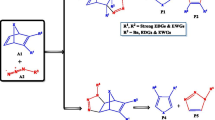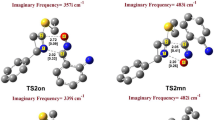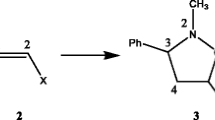Abstract
Conceptual density functional theory, including chemical hardness, electronic chemical potential, global and local electrophilicity index and Fukui functions, is used to predict reactivity and regioselectivity of 1,3-dipolar cycloadditions (13DCs) between five aryl azides (1–5) and an electron-deficient alkyne at the B3LYP/6-31G(d,p) level. Two reaction paths (a) and (b) are considered which result in the corresponding regioisomeric 1,2,3-triazoles P(1-5)a and P(1-5)b, respectively. All the 13DCs proceed via rather asynchronous TSs and the path (b) is clearly more synchronous than the path (a). All the reactions are high exoergic [∆Gº = −45.1 to −51.4 kcal/mol for path (a) and −47.7 to −55.9 kcal/mol for path (b)] with the moderate and nearly similar activation barriers (E a = 15.4–16.7 kcal/mol) referring a relatively low regioselectivity. All reactivity descriptors but one clearly suggest that path (a) is somewhat preferred over path (b). FMO interactions occur between HOMO13DP and LUMODPh due to the corresponding lower energy gap. All the reactions considered in this work classified as polar 13DCs with NED character. Our theoretical results are in good agreement with those reported experimentally.







Similar content being viewed by others
References
A. Padwa, W.H. Pearson (eds.), Synthetic Applications of 1,3-Dipolar Cycloaddition Chemistry Toward Heterocycles and Natural Products (Wiley, Hoboken, 2003)
M. Regitz, Phosphaalkynes: new building blocks in synthetic chemistry. Chem. Rev. 90, 191–213 (1990)
M.T. Nguyen, An analysis of reactant approach in concerted 1, 3-dipolar cycloadditions by the second moment of localized orbitals. J. Mol. Struct. (THEOCHEM) 105, 343–349 (1983)
L. Nyulaszi, P. Varnai, W. Eisfeld, M. Regitz, Regioselectivity in cycloaddition reaction between phosphaacetylene and diazomethane: an ab initio study. J. Comput. Chem. 18, 609–616 (1997)
R. Huisgen, 1, 3-dipolar cycloadditions: past and future. Angew. Chem. Int. Ed. 2, 565–632 (1963)
R.A. Firestone, Orientation in 1,3-dipolar cycloadditions according to the diradical mechanism: partial formal charges in the linnet structures of the diradical intermediates. J. Org. Chem. 37, 2181–2191 (1972)
S.A. Siadati, An example of a stepwise mechanism for the catalyst-free 1, 3-dipolar cycloaddition between a nitrile oxide and an electron rich alkene. Tetrahedron Lett. 56, 4857–4863 (2015)
P. Griess, Ueber diazocyanbenzol. Ber. Dtsch. Chem. Ges. 2, 369–370 (1869)
E.F.V. Scriven, K. Turnbull, Azides: their preparation and synthetic uses. Chem. Rev. 88, 297–368 (1988)
W.H. Pearson, P. S. Ramamoorthy in Encyclopedia of Reagents for Organic Synthesis, ed. by L. Paquette L. (Wiley, New York, 2004)
B. Souad, C.E. Fatmi, T. Mabrouk, Synthesis of some 1,4,5-trisubstituted 1,2,3-triazoles by 1,3-dipolarcycloaddition of 2-substituted phenyl azides to dimethyl acetylene dicarboxylate (DMAD), regular versus microwave irradiation: a comparative study. Rasayan. J. Chem. 4, 806–809 (2011)
K.N. Houk, J. Sims, C.R. Watts, L.J. Luskus, Origin of reactivity, regioselectivity, and periselectivity in 1, 3-dipolar cycloadditions. J. Am. Chem. Soc. 95, 7301–7315 (1973)
J. Geittner, R. Huisgen, R. Sustmann, Kinetics of 1, 3-dipolar cycloaddition reactions of diazomethane; a correlation with homo-lumo energies. Tetrahedron Lett. 18, 881–884 (1977)
D.G. Williamson, R.J. Cvetanovic, Rates of ozone-olefin reactions in carbon tetrachloride solutions. J. Am. Chem. Soc. 90, 3668–3672 (1968)
R. Huisgen, G. Szeimies, L. Mobius, 1.3-Dipolare cycloadditionen, XXXII. Kinetik der additionen organischer azide an CC-Mehrfachbindungen. Chem. Ber. 100, 2494–2507 (1967)
T.M.V.D. Pinho e Melo, Recent advances on the synthesis and reactivity of isoxazoles. Curr. Org. Chem. 9, 925–958 (2005)
K.N. Houk, Frontier molecular orbital theory of cycloaddition reactions. Acc. Chem. Res. 8, 361–369 (1975)
J. Barluenga, C. Valdes, G. Beltran, M. Escribano, F. Aznar, Developments in Pd catalysis: synthesis of 1H1,2,3-triazoles from sodium azide and alkenyl bromides. Angew. Chem. Int. Ed. 45, 6893–6896 (2006)
F. Himo, T. Lovell, R. Hilgraf, V.V. Rostovtsev, L. Noodleman, K.B. Sharpless, V.V. Fokin, Copper (I)-catalyzed synthesis of azoles. DFT study predicts unprecedented reactivity and intermediates. J. Am. Chem. Soc. 127, 210–216 (2005)
R.A. Firestone, Orientation in the 1, 3-dipolar cycloaddition of diazomethane and ethyl vinyl ether. J. Org. Chem. 41, 2212–2214 (1976)
L.R. Domingo, A new C–C bond formation model based on the quantum chemical topology of electron density. RSC Adv 4, 32415–32428 (2014)
J. Wei, J. Chen, J. Xu, L. Cao, H. Deng, W. Sheng, H. Zhang, W. Cao, Scope and regioselectivity of the 1,3-dipolar cycloaddition of azides with methyl 2-perfluoroalkynoates for an easy, metal-free route to perfluoroalkylated 1,2,3-triazoles. J. Fluor. Chem. 133, 146–154 (2012)
M.J. Frisch et al., Gaussian 03, Revision B.03 (Gaussian, Pittsburgh, 2003), p. 9
A.D. Becke, Density-functional thermochemistry. III. The role of exact exchange. J. Chem. Phys. 98, 5648–5652 (1993)
C. Lee, W. Yang, R.G. Parr, Development of the Colle-Salvetti correlation-energy formula into a functional of the electron density. Phys. Rev. B 37, 785–789 (1988)
R. Ditchfield, W.J. Hehre, J.A. Pople, Self-consistent molecular-orbital methods. IX. An extended Gaussian-type basis for molecular-orbital studies of organic molecules. J. Chem. Phys. 54, 724–728 (1971)
E. Paredes, R. Brasca, M. Kneeteman, P.M.E. Mancini, A novel application of the Diels–Alder reaction: nitronaphthalenes as normal electron demand dienophiles. Tetrahedron 63, 3790–3799 (2007)
C.N. Alves, A.S. Carneiro, J. Andres, L.R. Domingo, A DFT study of the Diels-Alder reaction between methyl acrolein derivatives and cyclopentadiene. Understanding the effects of Lewis acids catalysts based on sulfur containing boron heterocycles. Tetrahedron 62, 5502–5509 (2006)
L.R. Domingo, A density functional theory study for the Diels–Alder reaction between N-acyl-1-aza-1, 3-butadienes and vinylamines. Lewis acid catalyst and solvent effects. Tetrahedron 58, 3765–3774 (2002)
C. Della Rosa, C. Ormachea, M.N. Kneeteman, C. Adam, P.M.E. Mancini, Diels-Alder reactions of N-tosylpirroles developed in protic ionic liquids. Theoretical studies using DFT methods. Tetrahedron Lett. 52, 6754–6757 (2011)
P.M.E. Mancini, C.M. Ormachea, C.D. Della Rosa, M.N. Kneeteman, A.G. Suarez, L.R. Domingo, Ionic liquids and microwave irradiation as synergistic combination for polar Diels-Alder reactions using properly substituted heterocycles as dienophiles. A DFT study related. Tetrahedron Lett. 53, 6508–6511 (2012)
S. Bouacha, A.K. Nacereddine, A. Djerourou, A theoretical study of the mechanism, stereoselectivity and Lewis acid catalyst on the Diels–Alder cycloaddition between furan and activated alkenes. Tetrahedron Lett. 54, 4030–4033 (2013)
H.B. Schlegel, Optimization of equilibrium geometries and transition structures. J. Comput. Chem. 3, 214218 (1982)
A.E. Reed, F. Weinhold, Natural bond orbital analysis of near-Hartree–Fock water dimer. J. Phys. Chem. 78, 4066–4073 (1983)
W. Kohn, A.D. Becke, R.G. Parr, Density functional theory of electronic structure. J. Phys. Chem. 100, 12974–12980 (1996)
P.K. Chattaraj, U. Sarker, D. Ranjan Roy, Electrophilicity index. Chem. Rev. 106, 2065–2091 (2006)
L.R. Domingo, E. Chamorro, P. Perez, Understanding the reactivity of captodative ethylenes in polar cycloaddition reactions. A theoretical study. J. Org. Chem. 73, 4615–4624 (2008)
P. Geerlings, F. De Proft, W. Langenaeker, Conceptual density functional theory. Chem. Rev. 103, 1793–1874 (2003)
R.G. Parr, R.A. Donnelly, M. Levy, W.E. Palke, Electronegativity: the density functional viewpoint. J. Chem. Phys. 68, 3801–3807 (1978)
B. Gmez, P.K. Chattaraj, E. Chamorro, R. Contreras, P. Fuentealba, A density functional study of the claisen rearrangement of allyl aryl ether, allyl arylamine, allyl aryl thio ether, and a series of meta-substituted molecules through reactivity and selectivity profiles. J. Phys. Chem. A 106, 11227–11233 (2002)
R.G. Parr, R.G. Pearson, Absolute hardness: companion parameter to absolute electronegativity. J. Am. Chem. Soc. 105, 7512–7516 (1983)
T.A. Koopmans, Uber die zuordnung von wellenfunk tionen und eigenwerten zu den einzelenen electronen eines atoms. Physica 1, 104–113 (1934)
R.G. Pearson, Chemical hardness: applications from molecules to solids (Wiley-VCH Verlag GMBH, Weinheim, 1997)
P.K. Chattaraj, S. Sengupta, Popular electronic structure principles in a dynamical context. J. Phys. Chem. 100, 16126–16130 (1996)
R.G. Parr, L.V. Szentpaly, S. Liu, Electrophilicity index. J. Am. Chem. Soc. 121, 1922–1924 (1999)
L.R. Domingo, P. Perez, The nucleophilicity N index in organic chemistry. Org. Biomol. Chem. 9, 7168–7175 (2011)
S. Noorizadeh, H. Maihami, A theoretical study on the regioselectivity of Diels–Alder reactions using electrophilicity index. J. Mol. Struct. (THEOCHEM) 763, 133–144 (2006)
L.R. Domingo, S.R. Emamian, Understanding the mechanisms of [32] cycloaddition reactions. The pseudoradical versus the zwitterionic mechanism. Tetrahedron 70, 1267–1273 (2014)
L.R. Domingo, M.J. Aurell, P. Perez, A DFT analysis of the participation of zwitterionic TACs in polar [32] cycloaddition reactions. Tetrahedron 70, 1–7 (2014)
L.R. Domingo, M.J. Aurell, P. Perez, A mechanistic study of the participation of azomethine ylides and carbonyl ylides in [32] cycloaddition reactions. Tetrahedron 71, 1050–1057 (2015)
F. Mendez, J.L. Gazquez, Chemical reactivity of enolate ions: the local hard and soft acids and bases principle viewpoint. J. Am. Chem. Soc. 116, 9298–9301 (1994)
J.L. Gazquez, A. Martinez, F. Mendez, Relationship between energy and hardness differences. J. Phys. Chem. 97, 4059–4063 (1993)
A. Nouri, E. Zahedi, F.J. Jafari, A. Nouri, Diels–Alder reactions of α-cyano α, β-unsaturated ketones with 2-methyl-1, 3-butadiene: DFT study of mechanism, reactivity and regioselectivity. Prog. React. Kinet. Mech. 40, 177–189 (2015)
A.K. Chandra, M.T. Nguyen, Density functional approach to regiochemistry, activation energy, and hardness profile in 1, 3-dipolar cycloadditions. J. Phys. Chem. A 102, 6181–6185 (1998)
A.K. Chandra, M.T. Nguyen, Use of local softness for the interpretation of reaction mechanisms. Int. J. Mol. Sci. 3, 310–323 (2002)
W. Yang, W.J. Mortier, The use of global and local molecular parameters for the analysis of the gas-phase basicity of amines. J. Am. Chem. Soc. 108, 5708–5711 (1986)
H. Chemouri, S.M. Mekelleche, Elucidation of the substitutent effects on the reaction pathway of the cycloaddition of 1, 3-diazabuta-1, 3-dienes with ketenes using DFT-based reactivity indexes. J. Mol. Struct. (THEOCHEM) 813, 67–72 (2007)
L.R. Domingo, P. Perez, J.A. Saez, Understanding the local reactivity in polar organic reactions through electrophilic and nucleophilic Parr functions. RSC Adv. 3, 1486–1494 (2013)
S.A. Blair, A.J. Thakkar, How often is the minimum polarizability principle violated? Chem. Phys. Lett. 556, 346–349 (2013)
M. Torrent-Sucarrat, J.M. Luis, M. Duran, M. Sola, Are the maximum hardness and minimum polarizability principles always obeyed in nontotally symmetric vibrations? J. Chem. Phys. 117, 10561–10570 (2002)
Acknowledgments
The authors gratefully acknowledge The Research Council of the Islamic Azad University Shahr-e-Qods Branch.
Author information
Authors and Affiliations
Corresponding author
Rights and permissions
About this article
Cite this article
Dizaji, N.J., Nouri, A., Zahedi, E. et al. Regioselectivity of 1,3-dipolar cycloadditions between aryl azides and an electron-deficient alkyne through DFT reactivity descriptors. Res Chem Intermed 43, 767–782 (2017). https://doi.org/10.1007/s11164-016-2663-z
Received:
Accepted:
Published:
Issue Date:
DOI: https://doi.org/10.1007/s11164-016-2663-z




